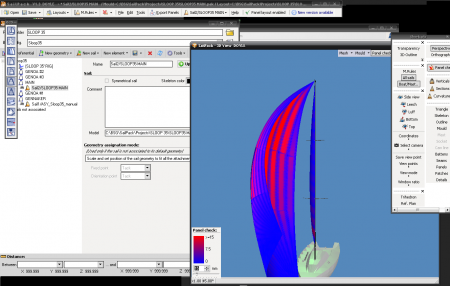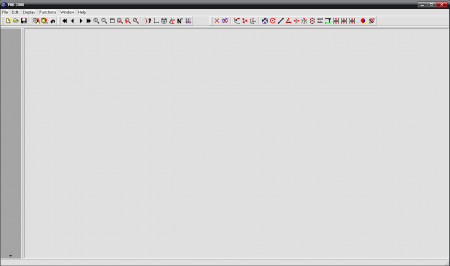SailPack - Sail Design Software
15-02-2012, 17:26. Author: vipsoft
SailPack Sail Design Software
SailPack - Sail Design Software is a revolutionary new sail production software package offering optimization of the sail design process.
The goal of SailPack software is to simplify and reduce the time required to design and produce sails.
Rigging & Geometry:
Sail Shape:
Measurement:
Panel Layout:
Patches & Reinforcements:
Battens:
Finishing Details & Outline Specifics:
Relax 2 :
Panel Management:
Printout:
Additional Information:
Rigging & Geometry:
Through the use of SailPack the user is able to create a realistic simulation of any number of possible rigging configurations (mast, pole, gaff, etc.). SailPack then builds on the position of deck fittings, including track and blocks, as specific to the yacht.
With SailPack the designer will be able to recreate and duplicate a realistic sail plan, specific to the hardware and rigging of the yacht. The designer can visualize any potential conflict or incompatibility between sail placement and rigging setup, allowing for modification and optimization of final sail geometry. In addition the sail designer can "hoist" and view a complete sail inventory.
Sail Shape:
SailPack gives the designer the ability to create a 3D surface of any possible geometry and sail shape (upwind sails and all downwind sails, including traditional or classic configurations such as a gaff-rigged boat). Data may be entered in either metric or imperial units.
With SailPack we can define the sail surface using any number of cross sections at any position. The sail outline is defined in 3D terms allowing for both lateral and longitudinal edge curvature.
A large number of tools combine to assist the designer in gaining a more realistic view of the work being done at any step of the process. These high quality 3D tools include seaming, mesh, net surface, panels, patches and all accessories.
A 'double-check' function is available to compare mould shape to your panel development.
In addition, the designer also has the power to view his or her sail designs from any angle of view or perspective – and is able to customize the default views in the software.
2D output information is shown in real time reflecting the resulting changes to the outline curve (before and after broadseaming). At 3D view of broadseam distribution is also integrated.
Each designer has the ability to create or customize their own set of shape u>evolution rules and integrate these within the SailPack software, building on their own set of standard mold shapes outlines available.
The SailPack system gives the designer the ability to use a minimal number of initial mold shapes and yet cover a wide range of sail configurations and applications - all within a very secure process. This is possible because SailPack has the ability to take into consideration and integrate both objective (aspect ratio, fabric type, etc.) and subjective (client helming characteristics, sea-state, etc.) parameters. Through these combinations the designer is able to customize, through a simple and automatic process, a unique design specific to the customer.
Measurement:
The designer has the ability to customize and “memorize”, within the SailPack software, any version of racing rules and measurement parameters. At any time during the sail design process the designer has the option of viewing the final measurements and area of the sail surface.
Panel Layout:
SailPack provides the ability to design any panel layout, without limitations, including curved seem paths. Controllable variables include seam angles, number of panels and panel widths. Panel layouts are created using a layout script.
* The concept of layout script within the SailPack software is very important in that only SailPack allows the designer to customize and ‘build on’ the layout process, versus the traditional, but limiting, copy & paste format.
SailPack software provides a variety of tools to identify potential panel layout conflicts and make necessary adjustments during the design process. These tools include the use of panel view, panel broadseam distribution and 3D curvature evaluation. The ability to view and control the quality and accuracy of the panel seaming and to control the meshing method in respect to the original mold is a crucial function which should result in a greatly reduced loft assembly time.
Patches & Reinforcements:
All types of reinforcements (radial, spider, multilayer, etc.) are possible using SailPack including spreader patch and any type of local reinforcements. The reinforcement design procedure is similar to the panel layout process. SailPack uses script to design and illustrate the composition of the patch. With SailPack any type of shape (elliptic, triangular, quadrangular or combination of), is achievable.
Battens:
Battens can be drawn directly into the sail (versus simply marked out at each end). The number, size, orientation and location of battens can be specified. In addition, SailPack gives the designer the ability to modify the outline of the sail and introduce hollow curve between battens.
Finishing Details & Outline Specifics:
Finishing details such as reef points, shape stripes, tell tales, slides placement, windows and sail number location can all be incorporated into the SailPack sail design and clearly defined in the final panel specs.
Relax 2:
In collaboration with Peter Heppel, BSG Développements has incorporated the necessary interface to export the SailPack panel layout and shape to Relax 2, aero-elastic evaluation software
Panel Management:
The output of the final design is a list of sail panels and reinforcement panels which are exported through the use of specialized software, MIB2000 (included in the SailPack software package)
Through MIB2000 the designer is able to modify (flip, rename, rotate, split) each individual panel as necessary. MIB2000 is able to export in all major plotter formats or exchange formats such as HPGL or DXF.
Printout:
Any 2D or 3D view of the sail may be printed or exported using a number of formats (PDF, Word, Excel,...). The designer can choose to print or file the final design as a production sheet, a design sheet and/or a panel layout sheet. With SailPack the designer can also choose to customize the sail data parameters into either/or both Word and Excel formats.,

